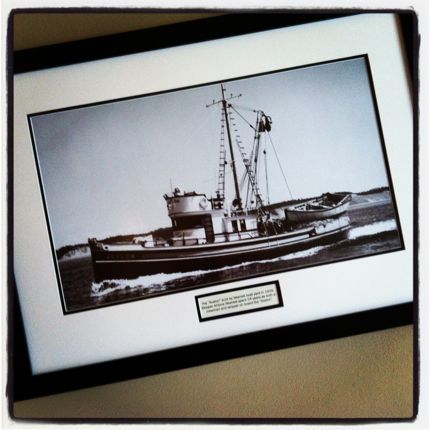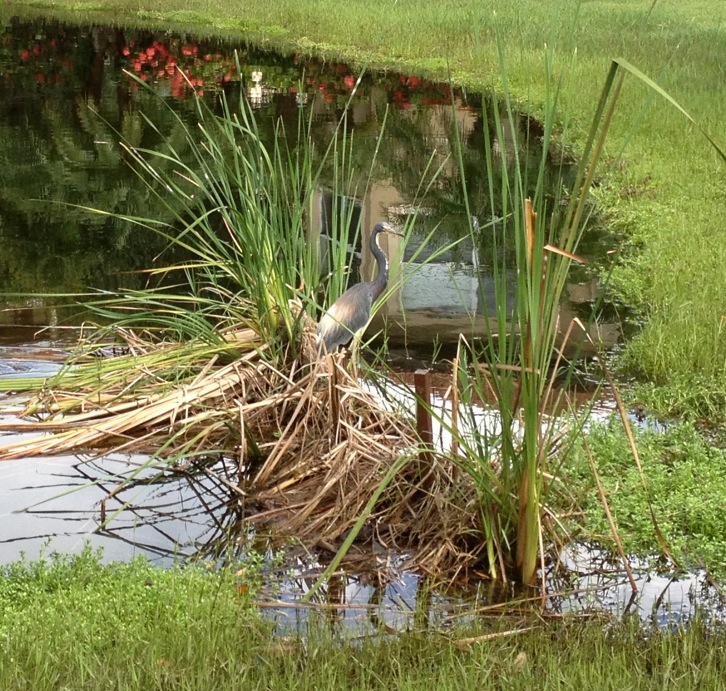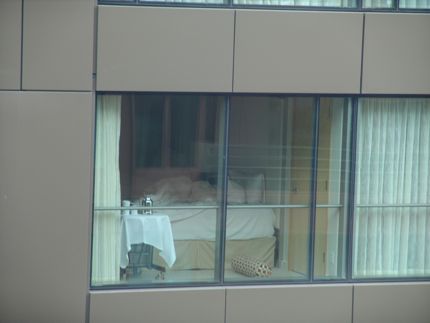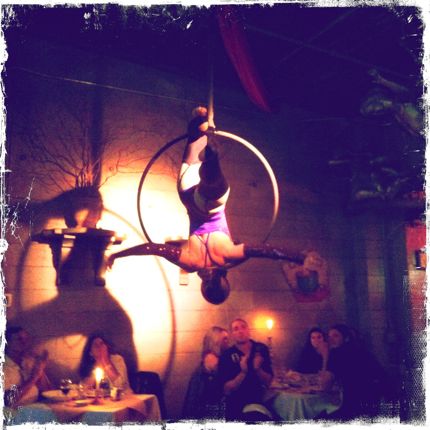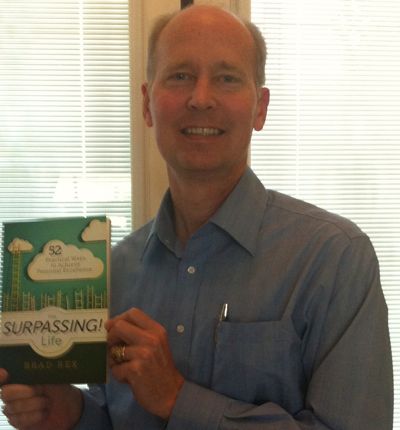
Inspiring Moment: Mostly Blue, One Green Flower
Written by Braiden Rex-Johnson
Comments and Praise
Uniform Races
Written by Brad Rex on August 30, 2012
Here is the fifth offering from one of our frequent guest columnists, Brad Rex. Not only is Brad my beloved brother, but he’s head of The Brad Rex Group, a consultant, noted public speaker, husband for 30 years, and father of three.
I’m proud to report that Brad’s new book, “The Surpassing! Life,” was published in May, so is now available for purchase here.
And I’m also honored to be among the first to excerpt parts of “Surpassing!” in the coming months.
Here’s his chapter entitled, Uniform Races, which gives valuable insights into something many of us struggle with on a daily basis: time management.
Uniform Races speaks to the Five More Minutes With zeitgeist because we should all value every moment, since life is fragile and precious and there are no guarantees. Carpe diem!
There is never enough time, unless you’re serving it.
Malcolm Forbes
He who every morning plans the transactions of the day and follows out that plan, carries a thread that will guide him through the maze of the most busy life. But where no plan is laid, where the disposal of time is surrendered merely to the chance of incidence, chaos will soon reign.
Victor Hugo
All my possessions for a moment of time.
Elizabeth I
How does a project get to be a year behind schedule?
One day at a time.
Fred Brooks
Besides active listening, the second most important skill for successful leaders is time management. A common refrain heard when talking about great leaders is, “How do they manage to do it all?”
The secret is effectively using every minute of every day. There are 525,600 minutes in a year. How well do you use each one?
I learned the value of a minute at the Naval Academy during my first year (Plebe) summer. Plebe summer is an intense training period when you are indoctrinated into the military way of life.
During the two months, you are purposefully required to do much more than can be physically done in the time allotted.
One of the favorite exercises during the summer is “uniform races.” All the plebes are lined up in the hall. An upperclassman yells out a uniform and a time (“Dress Whites. Two minutes. Go.”).
You are required to race back to your room, change into that uniform, and return within the specified time. Sometimes, you are required to take a shower or shave in between changing. Other times, you will be given instructions to put on different combinations of uniforms.
For the first few uniform races, very few plebes make it back in time. But, as the summer progresses, you learn how to optimize and shave seconds off each step in the process.
You start off thinking that you could never change in two minutes, and end up finding out that you can do it with time to spare. You find out just how much you can do in two minutes.
I learned the value of uniform races when the academic year started, and I had to change clothes quickly during the day. I also saw the value when I entered the business world, and often had to race from a late business meeting or flight and change clothes for dinner.
The best use of your time is to take a great time-management course. Lee Cockerell, former EVP of Operations for Walt Disney World, teaches a comprehensive and highly effective time management program. Lee is so passionate about time management that he taught the course to thousands of Cast Members when he was at Disney, and continues to teach the course to business leaders today. I encourage every leader to take this course.
A few of my suggestions regarding time management are:
• Write down your tasks. The strongest mind is no match for the weakest pen and paper. My to-do lists when I led Epcot often had over 150 items. There is no way I could ever remember that many things. By writing them down, I could ensure that nothing slipped through the cracks.
• Prioritize, prioritize, prioritize. Some people use an “A, B, C” system, while others use different symbols or time periods. No matter what you use, you have to make decisions about what needs to be done first.
• Review your items first thing in the morning and last thing in the evening. This gives you a plan for the day, and then feedback about how well you executed on your plan.
• Delegate and “automate.” I’ll talk about delegation in a later section. For “automate,” I am referring to creating habits for the things you do daily. For example, you shouldn’t have to think about working out or where you fit it in your calendar. You should have a daily habit of exercising at a particular time and just do it then. Your exercise time might be 6:30-7:30 a.m. every day. It is in your calendar that way, and you know that is when you work out. Morning and evening routines are not boring—they are a great way to simplify your life.
• Schedule time for the “important” as well as the “urgent.” Oftentimes, urgent items crowd out important items, when the important items are more critical to your long-term career. You should classify tasks into Urgent-Important; Not Urgent-Important; Urgent-Not Important; and, Not Urgent-Not Important. Clearly, the Urgent-Important tasks should have a high priority, while Not Urgent-Not Important tasks can most likely be delegated or not even done.
• Schedule thought and “blank” time. Leaders need thought time to develop strategies and process plans. You also need blank time to take care of the urgent items. One of my leaders, Eddie Carpenter, who was the Chief Financial Officer for Disney Parks and Resorts, would typically schedule the day before and the day after his vacations without any meetings. This allowed him to get everything accomplished before he left, and have a day to catch up when he returned, greatly reducing his stress and increasing his productivity.
• Be ruthless about getting rid of non-productive time. Always have something to read or do with you. With smartphones, you can answer e-mails, read newspapers, and make calls using your handheld device. Time is money, and work time is time that you could be spending with your family. Imagine that you are a lawyer that bills $500 per hour—over $8 per minute. Spending twenty minutes in an examining room waiting for a doctor would cost you $160. Don’t read old magazines—spend your time on your smartphone doing productive work.
• One of the best pieces of advice from Lee’s course is to “do something today that will benefit you in five years.” Many people get so caught up in the moment that they don’t do anything that will help them in the future. This might include taking care of your health, rebalancing your investment portfolio, or contacting someone you haven’t talked to in awhile.
John Lithgow said, “Time sneaks up on you like a windshield on a bug.” His statement is both humorous and accurate. You need to take control of your time, or risk getting squashed by life.
Action Items
• Recognize the value of time. A minute is a long time if you use it well.
• Take a time-management course and use either a paper planner or smartphone software to plan your day.
• Prioritize and review.
• Delegate and automate.
• Use waiting time effectively.
• Do something today that will not benefit you for five to 10 years.
Payoff
A full, rich, rewarding life with accomplishments beyond measure.
Comments and Praise
Inspiring Moment: Seattle Waterfront
Written by Braiden Rex-Johnson
Comments and Praise
Inspiring Moment: Splattered Paint
Written by Braiden Rex-Johnson
Comments and Praise
Five More Minutes With His Mother
Written by John Paul Carter on August 27, 2012
Today our frequent guest columnist, John Paul Carter, an ordained minister who writes for the Weatherford (Texas) Democrat, reflects on how our own life experiences continue to shape our memories of our parents in his story entitled, Still Getting to Know Mother.
My mother, who was born in 1903, has been dead for 32 years now. But strange as it may seem, I feel I know her – and my father – better now than I ever have in my life.
After my parents’ passing, I became aware of so much I didn’t know about their lives – especially their growing-up years and ancestry. This led me to trace their genealogy and learn more about the people and historical context that shaped them.
However, apart from this more recent gathering of data, knowing my parents better has been a long and gradual process, like the fermenting of grapes into fine wine.
As the events of my own life have unfolded and I’ve had time for reflection, a deeper understanding of my parents has evolved.
“Memory is more than a looking back to a time that no longer is,” says Buechner, “it is a looking out into another kind of time altogether where everything that ever was continues not just to be, but to grow and change with the life that is in it still.”
Many memories of my mother were my perceptions of her from a child’s perspective.
Some of what I remembered was accurate but other impressions were distorted.
As the Apostle Paul said, “When I was a child, I spoke like a child, I thought like a child, I reasoned like a child…”
Only later, as an adult, when I had children of my own, did I really begin to know my mother better.
One of many unforgettable insights happened as I drove home alone after leaving my daughter Kristen at A&M at the beginning of her freshman year.
From 25 years before, my mother’s face flashed into my mind as she weakly waved goodbye to me while I excitedly drove away to attend graduate school in Scotland.
After the guilt of my insensitivity had receded, I was grateful to better understand my mother’s mixed feelings.
When over the course of our lives, we, like our parents, have loved, worked, struggled, achieved, lost, rejoiced, grieved, enjoyed good days, survived hard times, aged, and looked death in the eye, then – and only then – can we come close to understanding and appreciating our parents and those who have loved us from the beginning.
Our own experiences continue to shape our memories of our parents.
To borrow a phrase from the title of a well-known book, sometimes it’s like meeting our parents again for the first time.
And, Buechner would add, “If they had things to say to us then, they have things to say to us now too, nor are they by any means things we expect or the same things.”
Lord, thank you for my parents and our still growing relationship.
Comments and Praise
Inspiring Moment: Mannequin Head
Written by Braiden Rex-Johnson
Comments and Praise
Five More Minutes With Poem: Messenger
Written by Braiden Rex-Johnson on August 23, 2012
This poem was written by Mary Oliver, a National Book Award- and Pulitzer Prize-winning poet whose work we have featured not once, but twice before on the Five More Minutes With website.
Here is her poem, “Messenger,” for your enjoyment.
My work is loving the world.
Here the sunflowers, there the hummingbird —
equal seekers of sweetness.
Here the quickening yeast; there the blue plums.
Here the clam deep in the speckled sand.
Are my boots old? Is my coat torn?
Am I no longer young, and still not half-perfect? Let me
keep my mind on what matters,
which is my work,
which is mostly standing still and learning to be
astonished.
The phoebe, the delphinium.
The sheep in the pasture, and the pasture.
Which is mostly rejoicing, since all ingredients are here,
which is gratitude, to be given a mind and a heart
and these body-clothes,
a mouth with which to give shouts of joy
to the moth and the wren, to the sleepy dug-up clam,
telling them all, over and over, how it is
that we live forever.
Comments and Praise
Inspiring Moment: Soup of the Day
Written by Braiden Rex-Johnsonn
Comments and Praise
Inspiring Moment: Yellow Lilies in a Glass Pitcher
Written by Braiden Rex-Johnson
Comments and Praise
The Tale of the Lone Seagull
Written by Kelly Tallariti on August 20, 2012
This story was written by Kelly Tallariti, the charming manager of our condominium building in downtown Seattle. Kelly manages to keep all of us unruly residents in line, always with a kind word and a smile. His warm heart really shows through in this recounting of a brush with nature just outside our doorstep. Thanks, Kelly.
And thanks also to Nick Spinarski, our multi-talented day door person and filmmaker who graduated from Cornish College of the Arts for the photo. He’s also working on a video of the bird that I will post once it’s completed.
After the frantic pace of the morning commute, saying hello and goodbye to residents hurriedly off to work , it felt like another routine Monday morning at 98 Union, or so I thought.
Sitting at my desk, worshipping a cup of ever-so-strong coffee, discussing the day’s tasks with Nick, I managed to focus on what appeared to be a lone bird standing tall on his duck-like feet looking in the door at me as if saying, “Will you please get the door for me? ”
Though not the prettiest of young birds, there was something unique about this one.
Alone and seemingly content, he remained right where he was as we opened the doors and greeted him.
Then, in he strolled! He looked around the lobby and then discovered something quite appealing–a bronze kick plate at the base of the entry door.
Hypnotized at seeing what appeared to be another creature who looked just like him in the reflection, he somehow knew he was okay, though orphaned.
His only path of travel for the day was in one door and out the other, from one brass kick plate to the other.
Attracting a crowd of onlookers and well wishers throughout the day, we knew something special was going on. We knew we couldn’t leave until this somehow tranquil and calming ugly-duckling seagull was safe.
Assuming he was orphaned, it was up to us (Nick and I), plus Holly (one of our resident’s assistants), to rescue him.
With much thought, we decided the best approach would be to gently carry him to the lower tower rooftop. We decided that perhaps, if he did accidentally float down from the nest, his family would have a better chance of seeing him there.
As we set him down on the rooftop our intuition was correct, at least for the moment. First one adult seagull, then the entire flock, came down to greet him as if saying, “Where did you go ? You gave us such a scare. How dare you leave the nest without our permission.”
But as fast as this seemingly happy reunion began, it instantly turned into a version of Alfred Hitchcock’s ” The Birds,” with flocks of gulls swarming over us, taking the young bird’s face into their beaks, and pecking as if to kill!!!
We all knew that this was probably not the motherly love we hoped it to be; indeed, quite the opposite.
So, off we went once again, whisking the small bird back into our hands. . .back to the familiar bronze kick plate where life was peaceful.
At least for the moment ……all was well again for our lone seagull.
But something still had to be done with our new friend, as his new home was clearly not in the reflection of a kick plate at 98 Union.
But where? Who? How?
Finally, after a bit of research, we discovered a Wildlife Rescue Shelter–Sarvey–that takes in orphaned and/or injured wildlife.
So once again off our orphaned seagull went with crate and mirror in a black Jeep on his way to what he would soon know as freedom.
Thank you lone bird for visiting us today at 98 Union and for bringing us all a little more peace…


